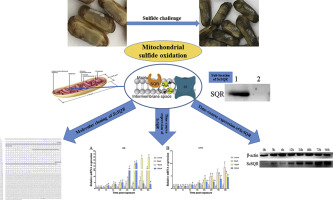当前位置:
X-MOL 学术
›
Comp. Biochem. Physiol. B Biochem. Mol. Biol.
›
论文详情
Our official English website, www.x-mol.net, welcomes your
feedback! (Note: you will need to create a separate account there.)
Molecular characterization of a novel sulfide:quinone oxidoreductase from the razor clam Sinonovacula constricta and its expression response to sulfide stress.
Comparative Biochemistry and Physiology B: Biochemistry & Molecular Biology ( IF 1.9 ) Pub Date : 2019-10-24 , DOI: 10.1016/j.cbpb.2019.110367 Yaoyao Shen 1 , Jiaqi Chen 2 , Weiliang Shen 3 , Caifang Chen 2 , Zhihua Lin 2 , Chenghua Li 4
Comparative Biochemistry and Physiology B: Biochemistry & Molecular Biology ( IF 1.9 ) Pub Date : 2019-10-24 , DOI: 10.1016/j.cbpb.2019.110367 Yaoyao Shen 1 , Jiaqi Chen 2 , Weiliang Shen 3 , Caifang Chen 2 , Zhihua Lin 2 , Chenghua Li 4
Affiliation

|
The razor clam Sinonovacula constricta is a commercial benthic bivalve, and burrows the deeper cave than the other buried benthic bivalves. Due to the little exchange of seawater and to anoxic conditions, S. constricta is exposed to considerable amounts of sulfide during low tide, but exhibits strong sulfide tolerance. Mitochondrial sulfide oxidation is a particular defense strategy against sulfide toxicity of sulfide-tolerant organisms, for which sulfide:quinone oxidoreductase (SQR) is the first key enzyme. In order to investigate the mechanism of sulfide tolerance in S. constricta, its SQR (designated as ScSQR), was cloned and characterized. The full-length cDNA of ScSQR was 3698 bp and encoded 443 amino acids. The deduced ScSQR protein contained conserved FAD-binding domains, two cysteine residues, two histidines, and one glutamic acid, which are the essential elements for the catalytic mechanism of SQR. Subcellular localization analysis by the TargetP 1.1 prediction and the Western blot confirmed that ScSQR was only located in the mitochondria. The response of ScSQR in the gill and liver of S. constricta were investigated during sulfide exposure (50, 150, and 300 μM sulfide) for 0, 3, 6, 12, 24, 48, 72, and 96 h by qRT-PCR. Moreover, the time-course expressions of ScSQR protein in the S. constricta gill were detected when exposed to 150 μM sulfide by Western blot. The expression level of ScSQR increased significantly and showed a time-dependent pattern. In addition, under sulfide stress, the expression level of the gill was higher than that of liver. Together, our results suggest that ScSQR may perform important roles in protecting cells from sulfide stress by participating in mitochondrial sulfide detoxification and providing high sulfide tolerance to S. constricta.
中文翻译:

剃刀蛤Sino中华nova的新型硫化物:醌氧化还原酶的分子表征及其对硫化物胁迫的表达响应。
剃刀蛤SinoSinonovacula constricta是一种商品底栖双壳类动物,比其他埋藏的底栖双壳类动物钻洞更深。由于海水交换少,且缺氧,低潮时during链霉菌暴露于大量的硫化物中,但对硫化物的耐受性强。线粒体硫化物氧化是抵抗耐硫化物生物的硫化物毒性的一种特殊防御策略,其中硫化物:醌氧化还原酶(SQR)是第一个关键酶。为了研究con链霉菌对硫化物的耐受性机理,克隆并鉴定了其SQR(称为ScSQR)。ScSQR的全长cDNA为3698 bp,编码443个氨基酸。推导的ScSQR蛋白包含保守的FAD结合结构域,两个半胱氨酸残基,两个组氨酸和一个谷氨酸,这是SQR催化机理的基本要素。通过TargetP 1.1预测和Western印迹进行的亚细胞定位分析证实,ScSQR仅位于线粒体中。通过qRT-PCR研究了硫化物(50、150和300μM硫化物)暴露0、3、6、12、24、48、72和96 h期间收缩链球菌g和肝脏中ScSQR的响应。此外,通过蛋白质印迹法检测到暴露于150μM硫化物时,在收缩链球菌strict中ScSQR蛋白的时程表达。ScSQR的表达水平显着增加,并呈时间依赖性。另外,在硫化物胁迫下,g的表达水平高于肝脏。一起,
更新日期:2019-10-24
中文翻译:

剃刀蛤Sino中华nova的新型硫化物:醌氧化还原酶的分子表征及其对硫化物胁迫的表达响应。
剃刀蛤SinoSinonovacula constricta是一种商品底栖双壳类动物,比其他埋藏的底栖双壳类动物钻洞更深。由于海水交换少,且缺氧,低潮时during链霉菌暴露于大量的硫化物中,但对硫化物的耐受性强。线粒体硫化物氧化是抵抗耐硫化物生物的硫化物毒性的一种特殊防御策略,其中硫化物:醌氧化还原酶(SQR)是第一个关键酶。为了研究con链霉菌对硫化物的耐受性机理,克隆并鉴定了其SQR(称为ScSQR)。ScSQR的全长cDNA为3698 bp,编码443个氨基酸。推导的ScSQR蛋白包含保守的FAD结合结构域,两个半胱氨酸残基,两个组氨酸和一个谷氨酸,这是SQR催化机理的基本要素。通过TargetP 1.1预测和Western印迹进行的亚细胞定位分析证实,ScSQR仅位于线粒体中。通过qRT-PCR研究了硫化物(50、150和300μM硫化物)暴露0、3、6、12、24、48、72和96 h期间收缩链球菌g和肝脏中ScSQR的响应。此外,通过蛋白质印迹法检测到暴露于150μM硫化物时,在收缩链球菌strict中ScSQR蛋白的时程表达。ScSQR的表达水平显着增加,并呈时间依赖性。另外,在硫化物胁迫下,g的表达水平高于肝脏。一起,









































 京公网安备 11010802027423号
京公网安备 11010802027423号